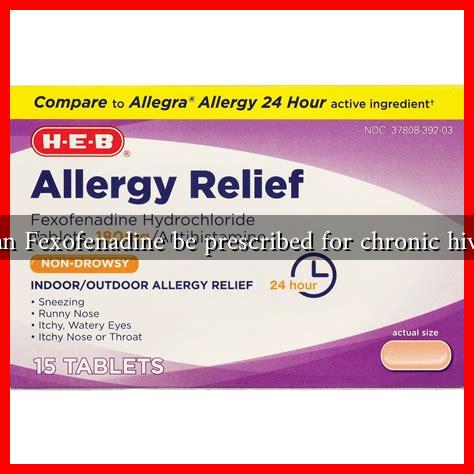-
Table of Contents
Can Fexofenadine be Prescribed for Chronic Hives?
Chronic hives, also known as chronic urticaria, is a condition characterized by the recurrent appearance of itchy welts on the skin that can last for six weeks or longer. This condition can significantly impact a person’s quality of life, leading to discomfort, sleep disturbances, and emotional distress. One of the medications often considered for managing chronic hives is fexofenadine, an antihistamine. This article explores the efficacy of fexofenadine in treating chronic hives, its mechanism of action, and relevant case studies.
Understanding Chronic Hives
Chronic hives can be idiopathic, meaning the exact cause is unknown, or it can be triggered by various factors such as allergens, medications, or underlying health conditions. The symptoms include:
- Itchy welts or hives that can vary in size
- Swelling of the skin
- Red or skin-colored welts
- Symptoms that can worsen with heat, stress, or exercise
According to the American Academy of Dermatology, chronic hives affect approximately 1% of the population, with women being more likely to experience this condition than men.
What is Fexofenadine?
Fexofenadine is a second-generation antihistamine commonly used to relieve allergy symptoms such as sneezing, runny nose, and itchy eyes. Unlike first-generation antihistamines, fexofenadine is less likely to cause sedation, making it a preferred choice for many patients. It works by blocking the action of histamine, a substance in the body that causes allergic symptoms.
Fexofenadine and Chronic Hives
Research indicates that fexofenadine can be effective in managing chronic hives. A study published in the Journal of Allergy and Clinical Immunology found that patients with chronic urticaria who were treated with fexofenadine experienced a significant reduction in the severity and frequency of hives compared to those who received a placebo.
Mechanism of Action
Fexofenadine works by:
- Blocking H1 receptors, which are responsible for the allergic response.
- Reducing the release of inflammatory mediators from mast cells.
- Providing symptomatic relief without causing sedation.
This mechanism makes fexofenadine a suitable option for patients suffering from chronic hives, especially those who need to maintain their daily activities without the drowsiness associated with first-generation antihistamines.
Case Studies and Clinical Evidence
Several case studies highlight the effectiveness of fexofenadine in treating chronic hives:
- A 2018 study involving 50 patients with chronic urticaria showed that 80% of participants reported significant improvement in their symptoms after four weeks of fexofenadine treatment.
- Another case study published in the International Journal of Dermatology documented a patient who had been suffering from chronic hives for over a year. After starting fexofenadine, the patient experienced complete resolution of symptoms within two weeks.
These examples underscore the potential benefits of fexofenadine as a treatment option for chronic hives.
Considerations and Side Effects
While fexofenadine is generally well-tolerated, some patients may experience side effects, including:
- Headache
- Dizziness
- Nausea
- Dry mouth
It is essential for patients to consult with their healthcare provider before starting any new medication, especially if they have underlying health conditions or are taking other medications.
Conclusion
Fexofenadine can be a valuable option for managing chronic hives, offering effective relief from symptoms with minimal sedation. With supportive clinical evidence and case studies demonstrating its efficacy, healthcare providers may consider prescribing fexofenadine for patients struggling with this challenging condition. As always, individual treatment plans should be tailored to each patient’s needs, and ongoing communication with healthcare professionals is crucial for optimal management of chronic hives.
For more information on chronic hives and treatment options, you can visit the American Academy of Dermatology.


